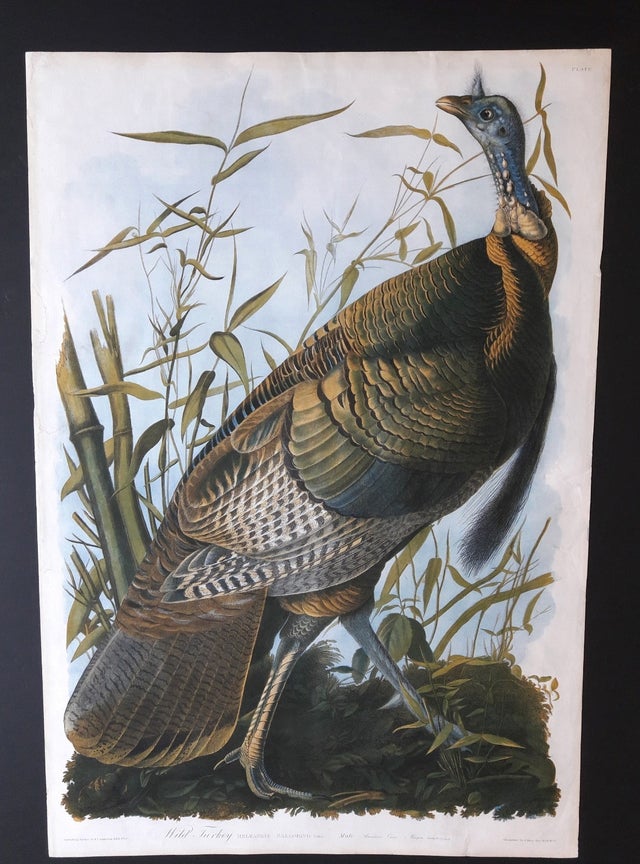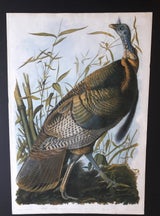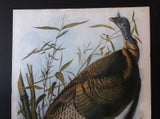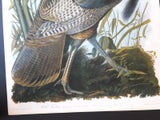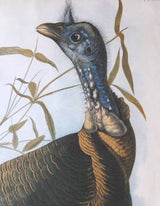- Home
- >
- Audubon's Bien Edition Birds (19th Century)
- >
- 287-Wild Turkey
287-Wild Turkey
SKU:
BE-287
$30,000.00
$26,000.00
$26,000.00
Unavailable
per item
Chromolithy by Julius Bien, New York, 1858. Excellent original colors including original hand-coloring on some areas on the bird. A few edge tears expertly repaired.
This is an iconic image that is probably instantly recognized by art collectors all over the world as an Audubon painting. It is the very first Plate in the "Birds of America." Painted by Audubon at the Beechwoods plantation near St. Francisville, Louisiana in 1825.
Audubon wrote "The great size and beauty of the Wild Turkey, its value as a delicate and highly prized article of food, and the circumstance of its being the origin of the domestic race now generally dispersed over both continents, render it one of the most interesting of the birds indigenous to the United States of America." Audubon encountered this bird frequently in the American wilderness. He honored this magnificent bird by making it the very first Plate in the Havell Edition of the "Birds of America". It is also the first Plate in the Bien Edition of the "Birds of America" published by his sons.
This is an iconic image that is probably instantly recognized by art collectors all over the world as an Audubon painting. It is the very first Plate in the "Birds of America." Painted by Audubon at the Beechwoods plantation near St. Francisville, Louisiana in 1825.
Audubon wrote "The great size and beauty of the Wild Turkey, its value as a delicate and highly prized article of food, and the circumstance of its being the origin of the domestic race now generally dispersed over both continents, render it one of the most interesting of the birds indigenous to the United States of America." Audubon encountered this bird frequently in the American wilderness. He honored this magnificent bird by making it the very first Plate in the Havell Edition of the "Birds of America". It is also the first Plate in the Bien Edition of the "Birds of America" published by his sons.
287-Wild Turkey
Chromolithy by Julius Bien, New York, 1858.
Bien Edition, Birds of America
The Bien edition prints of the Birds of America were produced by the Audubon family (by Audubon’s sons John Woodhouse and Victor Gifford), and thus are properly termed originals. Unlike the Havell edition prints which were produced in England, the Bien Edition prints were produced completely in America. Thus, they are truly American originals. In 1858, about seven years after John James Audubon passed away, his younger son John Woodhouse Audubon initiated an ambitious project to reissue the Birds of America to solve some of the mounting financial problems. He recruited the Roe Lockwood Company in New York city to publish the works and Julius Bien for lithography. Unlike the Havells which were produced from copper engraving plates, Julius Bien utilized the newly emerging chromolithography process as a way of reducing the costs of production. Chromolithography utilized a set of printing stones (about 6 or more, carrying images transferred from the original copper-plate engravings), each with different color printed in register to layer the colors to produce the final colored image on paper. Some of the final prints were hand-colored in specific areas to enhance the image. The use of different stones occasionally resulted in very slight misregister of colors on the dark outlines of birds and background, thus serving as a charming reminder of chromolithography process. Larger images were printed on a single page as in the Havell edition, whereas smaller images were printed two per page. All the larger images as well as some smaller images carry the credit "Chromolithy by J. Bien, New York, 1860” (but some with years between 1858 to 1862). Thus these images are commonly referred to as the Bien edition plates. Unfortunately, the start of the Civil War in 1860 brought an abrupt end to this project (and a financial ruin to the Audubon family) after only about 105 pages were printed. It was said that about 100 copies of each page (with bird images) were produced, but most of them did not survive. The Bien edition prints are more scarce to find than the Havell edition prints. For an excellent introduction to the Bien edition, please see the books by Susanne M. Low and Bill Steiner (books listed in the page about John James Audubon).
(Copyright, April 14, 2005, by the owner of AntiqueAudubon.Com)
Most of the prints available in this gallery are full sheets (~ 39" x 26"). Slightly trimmed prints are indicated. Please ask for detailed condition report before purchasing.
Bien Edition, Birds of America
The Bien edition prints of the Birds of America were produced by the Audubon family (by Audubon’s sons John Woodhouse and Victor Gifford), and thus are properly termed originals. Unlike the Havell edition prints which were produced in England, the Bien Edition prints were produced completely in America. Thus, they are truly American originals. In 1858, about seven years after John James Audubon passed away, his younger son John Woodhouse Audubon initiated an ambitious project to reissue the Birds of America to solve some of the mounting financial problems. He recruited the Roe Lockwood Company in New York city to publish the works and Julius Bien for lithography. Unlike the Havells which were produced from copper engraving plates, Julius Bien utilized the newly emerging chromolithography process as a way of reducing the costs of production. Chromolithography utilized a set of printing stones (about 6 or more, carrying images transferred from the original copper-plate engravings), each with different color printed in register to layer the colors to produce the final colored image on paper. Some of the final prints were hand-colored in specific areas to enhance the image. The use of different stones occasionally resulted in very slight misregister of colors on the dark outlines of birds and background, thus serving as a charming reminder of chromolithography process. Larger images were printed on a single page as in the Havell edition, whereas smaller images were printed two per page. All the larger images as well as some smaller images carry the credit "Chromolithy by J. Bien, New York, 1860” (but some with years between 1858 to 1862). Thus these images are commonly referred to as the Bien edition plates. Unfortunately, the start of the Civil War in 1860 brought an abrupt end to this project (and a financial ruin to the Audubon family) after only about 105 pages were printed. It was said that about 100 copies of each page (with bird images) were produced, but most of them did not survive. The Bien edition prints are more scarce to find than the Havell edition prints. For an excellent introduction to the Bien edition, please see the books by Susanne M. Low and Bill Steiner (books listed in the page about John James Audubon).
(Copyright, April 14, 2005, by the owner of AntiqueAudubon.Com)
Most of the prints available in this gallery are full sheets (~ 39" x 26"). Slightly trimmed prints are indicated. Please ask for detailed condition report before purchasing.
